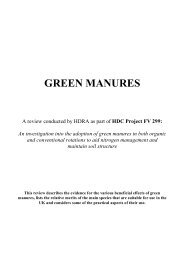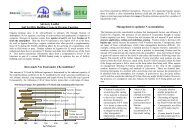A review of leguminous fertility-building crops, with particular ...
A review of leguminous fertility-building crops, with particular ...
A review of leguminous fertility-building crops, with particular ...
You also want an ePaper? Increase the reach of your titles
YUMPU automatically turns print PDFs into web optimized ePapers that Google loves.
A <strong>review</strong> <strong>of</strong> <strong>leguminous</strong> <strong>fertility</strong>-<strong>building</strong> <strong>crops</strong>, Defra project OF0316 2. Rotational aspects<br />
2.2. Disease implications <strong>of</strong> <strong>fertility</strong>-<strong>building</strong> <strong>crops</strong><br />
Consideration <strong>of</strong> disease interactions and implications <strong>with</strong> <strong>fertility</strong>-<strong>building</strong> <strong>crops</strong> needs to<br />
include:<br />
• Diseases affecting the <strong>fertility</strong>-<strong>building</strong> <strong>crops</strong> directly.<br />
• Diseases affecting <strong>fertility</strong>-<strong>building</strong> <strong>crops</strong> which will also affect other <strong>crops</strong> in rotation.<br />
• Consequences <strong>of</strong> incorporation <strong>of</strong> the <strong>fertility</strong>-<strong>building</strong> crop into soil: suppressive or<br />
antagonistic effects on soil- or air-borne pathogens.<br />
• Poor performance <strong>of</strong> the <strong>fertility</strong>-<strong>building</strong> crop has implications on the subsequent cash<br />
crop.<br />
Two types <strong>of</strong> cropping are considered:<br />
• Mono-cropping where specific <strong>fertility</strong>-<strong>building</strong> <strong>crops</strong> are grown exclusively for a period<br />
<strong>of</strong> time.<br />
• Bi-cropping or companion cropping systems where the <strong>fertility</strong>-<strong>building</strong> crop is grown<br />
<strong>with</strong> another arable or vegetable crop (but not necessarily completely synchronous <strong>with</strong><br />
it). In these systems, <strong>fertility</strong>-<strong>building</strong> <strong>crops</strong> are grown usually as an understorey <strong>with</strong><br />
arable or vegetable <strong>crops</strong>. Many <strong>of</strong> the principles applied to mono<strong>crops</strong> will still be<br />
valid, but there may be other direct benefits from the ‘physical’ presence <strong>of</strong> foliage <strong>of</strong> the<br />
companion crop, which interferes <strong>with</strong> disease activity.<br />
2.2.1. Diseases affecting the <strong>fertility</strong>-<strong>building</strong> <strong>crops</strong> directly.<br />
Diseases <strong>of</strong> forage and grass <strong>crops</strong> have been documented (O’Rourke, 1976) and, in some<br />
circumstances, specific problems may lead to failure or impaired productivity <strong>of</strong> <strong>fertility</strong><strong>building</strong><br />
<strong>crops</strong>. However, disease resistant cultivars are <strong>of</strong>ten available and can be used to<br />
overcome problems or reduce risks <strong>of</strong> problems. Local knowledge <strong>of</strong> diseases in the <strong>crops</strong><br />
selected for <strong>fertility</strong>-<strong>building</strong> is important, as is the potential for disease spread from related<br />
crop species nearby. For example, stubble turnips are very prone to dark leaf spot<br />
(Alternaria brassicae), which is common in other forage and vegetable brassicas and oilseed<br />
rape.<br />
2.2.2. Diseases transfer from <strong>fertility</strong>-<strong>building</strong> <strong>crops</strong><br />
The legacy <strong>of</strong> disease problems left by <strong>fertility</strong>-<strong>building</strong> <strong>crops</strong> is <strong>of</strong> major concern to<br />
growers. The extent <strong>of</strong> problems will be influenced strongly by previous cropping and<br />
its legacy <strong>of</strong> the soil pathogen population on the field or farm. Thus, farms <strong>with</strong> a<br />
history <strong>of</strong> legume cropping are likely to carry high populations <strong>of</strong> pathogens affecting<br />
legumes, whilst few legume pathogens may be present where legumes have not been<br />
grown for many years. Very intensive legume cropping may leave high soil populations<br />
<strong>of</strong> fungal pathogens which will only decline slowly.<br />
Root and foot rot pathogens (e,g Fusarium spp., Pythium spp., Phoma medicaginis) are<br />
economically important in arable and vegetable cropping, <strong>with</strong> field evidence indicating that<br />
there are interactions between different legume types such as Pisum, Phaseolus and Vicia<br />
spp.. The intensity <strong>of</strong> total legume types and the intensity <strong>of</strong> total legume cropping<br />
influences disease severity (Biddle, 1984). Ideally, there should be at least a five-year<br />
interval between legume <strong>crops</strong> (Biddle, 1984). The influence <strong>of</strong> forage legume cropping on<br />
the disease risk to subsequent legume <strong>crops</strong> requires further investigation.<br />
Written by S Cuttle, M Shepherd & G Goodlass Page 28




